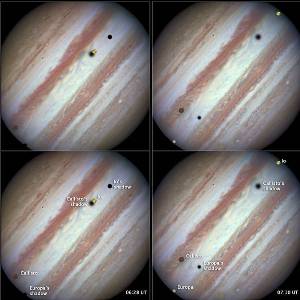
Photo: NASA, ESA, and the Hubble Heritage Team (STScI/AURA)
WASHINGTON (PTI): NASA's Hubble Space Telescope has captured the rare occurrence of three of Jupiter's largest moons racing across the face of the gas-giant planet.
Europa, Callisto and Io complete orbits around Jupiter with durations ranging from 2 days to 17 days.
They can commonly be seen transiting the face of Jupiter and casting shadows onto its cloud tops. However, seeing three moons transiting the face of Jupiter at the same time is rare, occurring only once or twice a decade, researchers said.
The Hubble images captured the rare occurrence on January 24.
The images were taken with Hubble's Wide Field Camera 3 in visible light.
The moons in the photos have distinctive colours. The ancient cratered surface of Callisto is brownish; the smooth icy surface of Europa is yellow-white; and the volcanic, sulfur-dioxide surface of Io is orange.
The moon Ganymede is missing from the photos as it was outside Hubble's field of view and too far from Jupiter in angular separation to be considered part of this conjunction.
The planet Jupiter has over 60 moons. The four large moons - Io, Europa, Ganymede and Callisto - are called the Galilean moons after the 17th century scientist Galileo Galilei who discovered them.
 Previous Article
Previous Article Next Article
Next Article













The Indian Air Force, in its flight trials evaluation report submitted before the Defence Ministry l..
view articleAn insight into the Medium Multi-Role Combat Aircraft competition...
view articleSky enthusiasts can now spot the International Space Station (ISS) commanded by Indian-American astr..
view article